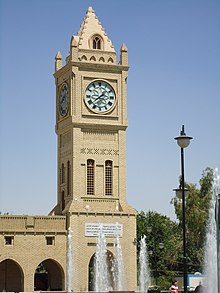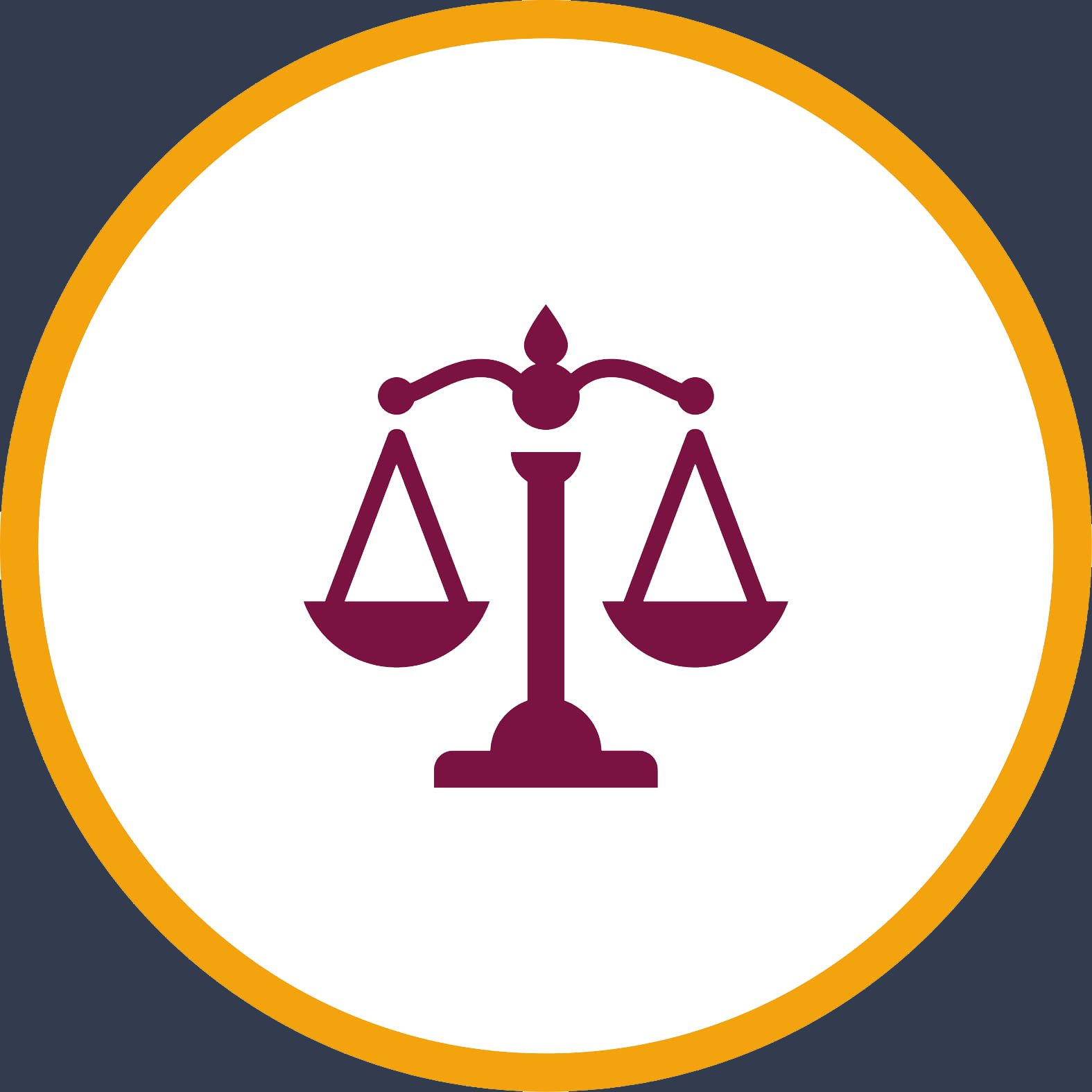Modern history
Erbil lies on the plain beneath the mountains, but for the most part, the inhabitants of Iraqi Kurdistan dwell up above in the rugged and rocky terrain that is the traditional habitat of the Kurds since time immemorial. [42]
The modern town of Erbil stands on a tell topped by an Ottoman fort. During the Middle Ages, Erbil became a major trading center on the route between Baghdad and Mosul, a role which it still plays today with important road links to the outside world.
Erbil is also home to a large population of refugees due to ongoing conflicts in Syria and in the rest of Iraq. In 2020, it was estimated that 450,000 refugees had settled in the Erbil metropolitan area since 2003, with many of them expected to remain.[43]
The parliament of the Kurdistan Autonomous Region was established in Erbil in 1970 after negotiations between the Iraqi government and the Kurdistan Democratic Party (KDP) led by Mustafa Barzani, but was effectively controlled by Saddam Hussein until the Kurdish uprising at the end of the 1991 Gulf War. The legislature ceased to function effectively in the mid-1990s when fighting broke out between the two main Kurdish factions, the Kurdistan Democratic Party and the Patriotic Union of Kurdistan (PUK). The city was captured by the KDP in 1996 with the assistance of the Iraqi government of Saddam Hussein. The PUK then established an alternative Kurdish government in Sulaimaniyah. KDP claimed that on March 1996 PUK asked for Iran’s help to fight KDP. Considering this as a foreign attack on Iraq’s soil, the KDP asked Saddam Hussein for help.
The Kurdish Parliament in Erbil reconvened after a peace agreement was signed between the Kurdish parties in 1997, but had no real power. The Kurdish government in Erbil had control only in the western and northern parts of the autonomous region. During the 2003 Invasion of Iraq, a United States special forces task force was headquartered just outside Erbil. The city was the scene of celebrations on 10 April 2003 after the fall of the Ba’ath regime.
During the coalition forces occupation of Iraq, sporadic attacks hit Erbil. Parallel bomb attacks against Eid celebrations killed 109 people on 1 February 2004.[44] Responsibility was claimed by the Ansar al-Sunnah.[44] A suicide bombing on 4 May 2005 killed 60 civilians and injured 150 more outside a police recruiting centre.[45]
The Erbil International Airport opened in the city in 2005.
In 2015, the Assyrian Church of the East moved its seat from Chicago to Erbil.
In February 2021, a series of missiles hit the city killing 2 and injuring 8 people.
Transportation
Erbil International Airport is one of Iraq’s busiest airports and it is near the city. Services include direct flights to many domestic destinations such as Baghdad international airport. There are international flights from Erbil to many countries; such as the Netherlands, Germany, Saudi Arabia, Austria, Turkey, Jordan and many more flights elsewhere around the world. There are occasionally seasonal flights from Erbil international airport. Erbil International Airport was briefly closed to international commercial flights in September 2017 by the Iraqi government in retaliation for the Kurdish independence vote but reopened in March 2018.[46][47]
Another important form of transportation between Erbil and the surrounding areas is by bus. Among others, bus services offer connections to Turkey and Iran. A new bus terminal was opened in 2014.[48] Erbil has a system of five ring roads encirling the city.[49]
Climate
Erbil has a Mediterranean climate (Köppen climate classification Csa), with long, extremely hot summers and mild winters. Summer months are extremely dry, with little to no precipitation occurring between June and September. Winters are usually wet and humid, with January being the wettest month.[50]
| hideClimate data for Erbil | |||||||||||||
|---|---|---|---|---|---|---|---|---|---|---|---|---|---|
| Month | Jan | Feb | Mar | Apr | May | Jun | Jul | Aug | Sep | Oct | Nov | Dec | Year |
| Average high °C (°F) | 12.4 (54.3) |
14.2 (57.6) |
18.1 (64.6) |
24.0 (75.2) |
31.5 (88.7) |
38.1 (100.6) |
42.0 (107.6) |
41.9 (107.4) |
37.9 (100.2) |
30.7 (87.3) |
21.2 (70.2) |
14.4 (57.9) |
27.2 (81.0) |
| Daily mean °C (°F) | 7.4 (45.3) |
8.9 (48.0) |
12.4 (54.3) |
17.5 (63.5) |
24.1 (75.4) |
29.7 (85.5) |
33.4 (92.1) |
33.1 (91.6) |
29.0 (84.2) |
22.6 (72.7) |
15.0 (59.0) |
9.1 (48.4) |
20.2 (68.3) |
| Average low °C (°F) | 2.4 (36.3) |
3.6 (38.5) |
6.7 (44.1) |
11.1 (52.0) |
16.7 (62.1) |
21.4 (70.5) |
24.9 (76.8) |
24.4 (75.9) |
20.1 (68.2) |
14.5 (58.1) |
8.9 (48.0) |
3.9 (39.0) |
13.2 (55.8) |
| Average rainfall mm (inches) | 111 (4.4) |
97 (3.8) |
89 (3.5) |
69 (2.7) |
26 (1.0) |
0 (0) |
0 (0) |
0 (0) |
0 (0) |
12 (0.5) |
56 (2.2) |
80 (3.1) |
540 (21.2) |
| Average rainy days | 9 | 9 | 10 | 9 | 4 | 1 | 0 | 0 | 1 | 3 | 6 | 10 | 62 |
| Average snowy days | 1 | 0 | 0 | 0 | 0 | 0 | 0 | 0 | 0 | 0 | 0 | 0 | 1 |
| Average relative humidity (%) | 75 | 70 | 65 | 59 | 42 | 29 | 25 | 28 | 31 | 44 | 61 | 76 | 50 |
| Source 1: Climate-Data.org,[50] My Forecast for records, humidity, snow and precipitation days[51] | |||||||||||||
| Source 2: What’s the Weather Like.org,[52] Erbilia[53] | |||||||||||||
Culture
Citadel of Erbil
The Citadel of Erbil is a tell or occupied mound in the historical heart of Erbil, rising between 25 and 32 metres (82 and 105 ft) from the surrounding plain. The buildings on top of the tell stretch over a roughly oval area of 430 by 340 metres (1,410 ft × 1,120 ft) occupying 102,000 square metres (1,100,000 sq ft). It has been claimed that the site is the oldest continuously inhabited town in the world.[54] The earliest evidence for occupation of the citadel mound dates to the 5th millennium BC and possibly earlier. It appears for the first time in historical sources during the Ur III period and gained particular importance during the Neo-Assyrian Empire (10th to 7th centuries BC) period. West of the citadel at Ary Kon quarter, a chamber tomb dating to the Neo-Assyrian Empire period has been excavated.[13] During the Sassanian period and the Abbasid Caliphate, Erbil was an important centre for Assyrian Christianity and the Assyrians in general. After the Mongols captured the citadel in 1258, Erbil’s importance began to decline. The main gate is guarded by an immense statue of a Kurd reading. The house of the citadel behind him are built into stony ground of the mound and look down on the streets and tarmacked roads that circle them.
During the 20th century, the urban structure was significantly modified, as a result of which a number of houses and public buildings were destroyed. In 2007, the High Commission for Erbil Citadel Revitalization (HCECR) was established to oversee the restoration of the citadel. In the same year, all inhabitants, except one family, were evicted from the citadel as part of a large restoration project. Since then, archaeological research and restoration works have been carried out at and around the tell by various international teams and in co-operation with local specialists, and many areas remain off-limits to visitors due to the danger of unstable walls and infrastructure. The government plans to have 50 families live in the citadel once it is renovated.
The only religious structure that currently survives in the citadel is the Mulla Afandi Mosque. When it was fully occupied, the citadel was divided in three districts or mahallas: from east to west the Serai, the Takya and the Topkhana. The Serai was occupied by notable families; the Takya district was named after the homes of dervishes, which are called takyas; and the Topkhana district housed craftsmen and farmers. Other sights to visit in the citadel include the bathing rooms (hammam) built in 1775 located near the mosque and the Textile Museum.[55] Erbil citadel has been inscribed on the World Heritage List on 21 June 2014 .
Other sights
- The covered Erbil Qaysari Bazaars, lying below the main entrance to the citadel and stocking mainly household goods and tools.
- The 36-metre-high (118-foot) Mudhafaria Minaret, situated in Minaret Park several blocks from the citadel, dates back to the late 12th century AD and the Governor of Erbil, in the reign of Saladin, Muzaffar Al-Din Abu Sa’eed Al-Kawkaboori (Gökböri), who had entered in the obedience of Salahuddin without war and married his sister. It has an octagonal base decorated with two tiers of niches, which is separated from the main shaft by a small balcony, also decorated. Another historical minaret with turquoise glazed tiles is nearby.
- Sami Abdul Rahman Park
- The Mound of Qalich Agha lies within the grounds of the Museum of Civilization, 1 kilometre (0.62 mi) from the citadel. An excavation in 1996 found tools from the Halaf, Ubaid and Uruk periods.[13]
- Illusion Museum Erbil
- Kurdish Textile Museum
Sports[edit]
The local major football team is Erbil Soccer Club which plays its football matches at Franso Hariri Stadium (named after the assassinated Assyrian politician, former governor of Erbil city Franso Hariri) which is based in the south part of central Erbil. Erbil Football Team Wins 3 Iraqi nation league and reached the AFC Final twice, but lost both times.
Media
- Babylon FM
- Ishtar TV
- Kanal4
- Kurdistan 24
- Kurdistan TV
- Kurdmax Pepûle
- Kurdsat
- Net TV
- Rebaz Multimedia
- Rudaw Media Network
- Ava Entertainment
- Korek TV
- I Star
- I Star Sport
- I Star Quran
- new line HD
- Speda Channel
- NRT TV
See also
| Wikimedia Commons has media related to Arbil. |
- Kurdistan
- Ankawa – a suburb
- Erbil Governorate
- Erbil International Airport – capital’s airport in Kurdistan
- List of cities of the ancient Near East
References
- ^ “ھەولێر”. chawykurd.com. چاوی کورد. Retrieved 2 December2020.
- ^ Jump up to:a b “Iraq”. CITY POPULATION. Retrieved 5 November 2020.
- ^ “Hewlêr dixwaze Bexda paşekeftiya mûçeyan bide” (in Kurdish). Retrieved 28 December 2019.
- ^ “أربيل”. Aljazeera (in Arabic). Retrieved 28 December 2019.
- ^ “Search Entry”. www.assyrianlanguages.org. Retrieved 26 May 2021.
- ^ Khan, Geoffrey (1999). A Grammar of Neo-Aramaic: The Dialect of the Jews of Arbel. BRILL. p. 2. ISBN 978-90-04-30504-5.
There are a number of variant forms of the name Arbel. The form Arbel, which is used throughout this book, is the Neo-Aramaic form of the name. The Arabic-speaking Jews of the town refer to it as Arbīl or Arwīl. In Classical Arabic sources it is known as Irbīl. The Kurds call it Hawler, which appears to have developed from the form Arbel by a series of metatheses of consonants. The name appears to be of non-Semitic origin. It is first found in cuneiform texts dating to the 3rd millennium B.C., where it usually has the form Urbilum.
- ^ Danilovich, Alex (12 October 2018). Federalism, Secession, and International Recognition Regime: Iraqi Kurdistan. Routledge. ISBN 9780429827655.
- ^ “İşte Kürdistan Bölgesi’nin nüfusu…”. Rudaw.net.
- ^ Novice, Karel (2008). “Research of the Arbil Citadel, Iraq, First Season”. Památky Archaeological (XCIX): 259–302.
- ^ Villard 2001
- ^ Jump up to:a b Hamblin, William J. (2006). Warfare in the Ancient Near East to 1600 BC. Routledge. p. 111. ISBN 0-415-25589-9.
- ^ Georges Roux – Ancient Iraq
- ^ Jump up to:a b c ‘Directorate Antiquities of Erbil’s Guide’ Brochure produced by General Directorate of Antiquities, KRG, Ministry of Tourism
- ^ Erbil named 2014 Arab Tourism Capital. Retrieved 30 January 2014
- ^ “Erbil: Kurdish City, Arab Capital”, Rudaw. Retrieved 30 January 2014
- ^ “Iraqi Turkmen”. Minority Rights Group International. Retrieved 17 October 2020.
- ^ “9781906768188: Kurdistan – a Nation Emerges – AbeBooks – Jonathan Fryer: 1906768188”. www.abebooks.co.uk. Retrieved 22 January 2021.
- ^ Hansman, J. F. (1986). “ARBELA”. Encyclopaedia Iranica, Vol. II, Fasc. 3. pp. 277–278.
- ^ Sourdel, D. (1978). “Irbil”. In van Donzel, E.; Lewis, B.; Pellat, Ch. & Bosworth, C. E. (eds.). The Encyclopaedia of Islam, New Edition, Volume IV: Iran–Kha. Leiden: E. J. Brill. OCLC 758278456.
- ^ Kessler, Karlheinz (2006). “Arbela”. In Salazar, Christine F.; Landfester, Manfred; Gentry, Francis G. (eds.). Brill’s New Pauly. Brill Online.
- ^ Statistics. “UNPO: Assyria”. unpo.org.
- ^ Timeline Archived 14 August 2014 at the Wayback MachineErbilCitadel.orq
- ^ electricpulp.com. “ASAGARTA (Sagartia) – Encyclopaedia Iranica”. iranicaonline.org. Archived from the original on 18 December 2016. Retrieved 14 September 2011.
- ^ Yarshater, Ehsan (1993). The Cambridge History of Iran, Volume 3. Cambridge University Press. p. 482. ISBN 978-0-521-20092-9.
Of the four residences of the Achaemenids named by Herodotus—Ecbatana, Pasargadae or Persepolis, Susa and Babylon—the last [situated in Iraq] was maintained as their most important capital, the fixed winter quarters, the central office of bureaucracy, exchanged only in the heat of summer for some cool spot in the highlands. Under the Seleucids and the Parthians the site of the Mesopotamian capital moved slightly to the north on the Tigris—to Seleucia and Ctesiphon. It is indeed symbolic that these new foundations were built from the bricks of ancient Babylon, just as later Baghdad, a little further upstream, was built out of the ruins of the Sassanian double city of Seleucia-Ctesiphon.
- ^ Jump up to:a b In the Targum to Jeremiah li. 27, Ararat, Minni, and Ashkenaz are paraphrased by Kordu, Harmini, and Hadayab, i.e., Corduene, Armenia, and Adiabene; while in Ezekiel xxvii. 23 Harran, Caneh, and Eden are interpreted by the Aramaictranslator as “Harwan, Nisibis, and Adiabene.”
- ^ Jump up to:a b “‘The descendants of Gomer: Ashkenaz, Riphath, and Togarmah (Genesis 10:3)’: Asia, Adiabene, and Germania. Rabbi Berechya said: ‘Germanica’.” http://sefaria.org/Bereishit_Rabbah.37.1?ven=Sefaria_Community_Translation&with=all&lang=en
- ^ Adiabene, Jewish Kingdom of Mesopotamia Archived 12 July 2009 at the Portuguese Web Archive, Jonah Gabriel Lissner
- ^ MŠIHA-ZKHA. “HISTORY OF THE CHURCH OF ADIABENE UNDER THE PARTHIANS AND THE SASSANIDS”. Tertullian.org.
- ^ Neusner, Jacob (1969). A history of the Jews in Babylonia, Volume 2. Brill Archive. p. 354.
- ^ Jump up to:a b British Institute of Persian Studies (1981). Iran, Volumes 19–21. the University of Michigan. pp. 15, 17.
- ^ Gillman, Ian and Hans-Joachim Klimkeit. Christians in Asia before 1500. (Ann Arbor: University of Michigan, 1999) p. 33
- ^ V. Minorsky. Studies in Caucasian History III, Prehistory of Saladin. Cambridge University Press. 208 pp. 1953.
- ^ Nováček, K., Amin, N., & Melčák, M. (2013). A Medieval City Within Assyrian Walls: The Continuity of the Town of Arbīl in Northern Mesopotamia. Iraq, 75, 1-42. doi:10.1017/S0021088900000401
- ^ B. James. Le « territoire tribal des Kurdes » et l’aire iraqienne (xe-xiiie siècles): Esquisse des recompositions spatiales. Revue des Mondes Musulmans et de la Méditerranée, 2007. P. 101-126.
- ^ Woods 1977, pp. 49–50
- ^ Nováček et al. 2008, p. 261
- ^ J. von Hammer-Purgstall. 1842. Geschichte der Ilchane, das ist der Mongolen in Persien, Volume 1. P. 159-161.
- ^ Grousset, p. 379
- ^ Sourdel 2010
- ^ Grousset, p. 383
- ^ Edwin Munsell Bliss, Turkey and the Armenian Atrocities, (Chicago 1896) p. 153
- ^ “9781906768188: Kurdistan – a Nation Emerges – AbeBooks – Jonathan Fryer: 1906768188”. www.abebooks.co.uk. Retrieved 22 January 2021.
- ^ “Interview with Nihad Salim Qoja: “Iranian hegemony in Iraq is very strong” – Qantara.de”. Qantara.de – Dialogue with the Islamic World. Retrieved 18 July 2020.
- ^ Jump up to:a b Al-Nahr, Naseer (2 February 2004). “Twin Bombings Kill 56 in Irbil”. Arabnews.com. Retrieved 11 May 2015.
- ^ Jaff, Warzer; Oppel Jr., Richard A. (5 May 2005). “60 Kurds Killed by Suicide Bomb in Northern Iraq”. The New York Times. Retrieved 11 May 2015.
- ^ Blockade by Iraq (29 September 2017). “Iraqi govt enforces international flight ban in Kurdistan region”. France 24.
- ^ International Flight Return. “Erbil International Airport”. erbilairport.com.
- ^ “Erbil’s New Bus Terminal a Boon for Travelers”. Rudaw. 4 April 2019. Retrieved 19 March 2019.
- ^ “Erbil’s 5th ring road completed – the 120 Meter highway”. Rudaw. 2 May 2017. Retrieved 19 March 2019.
- ^ Jump up to:a b “Climate: Arbil – Climate graph, Temperature graph, Climate table”. Climate-Data.org. Retrieved 13 August 2013.
- ^ “Irbil, Iraq Climate”. My Forecast. Retrieved 14 July 2013.
- ^ “Erbil climate info”. What’s the Weather Like.org. Retrieved 14 July 2013.
- ^ “Erbil Weather Forecast and Climate Information”. Erbilia. Archived from the original on 9 July 2013. Retrieved 14 July2013.
- ^ “Erbil Citadel”. UNESCO. Retrieved 30 August 2010.
- ^ ‘Erbil Citadel’ Brochure, High Commission for Erbil Citadel Revitalization (HCECR). www.erbilcitadel.org
Sources
- Sourdel, D. (2010), “Irbil”, in Bearman, P.; Bianquis, Th.; Bosworth, C.E.; van Donzel, E.; Heinrichs, W.P. (eds.), Encyclopaedia of Islam, Second Edition, Brill Online, OCLC 624382576
- Grousset, René, The Empire of the Steppes, (Translated from the French by Naomi Walford), New Brunswick: Rutgers University Press (1970)
External links
| Wikivoyage has a travel guide for Erbil. |
- Hawler Governorate
- Erbil – Portal for international visitors
- Livius.org: Arbela
- Erbil Information Guide
- Hawler/Erbil visitor’s guide
- Erbil seen through camera lens













